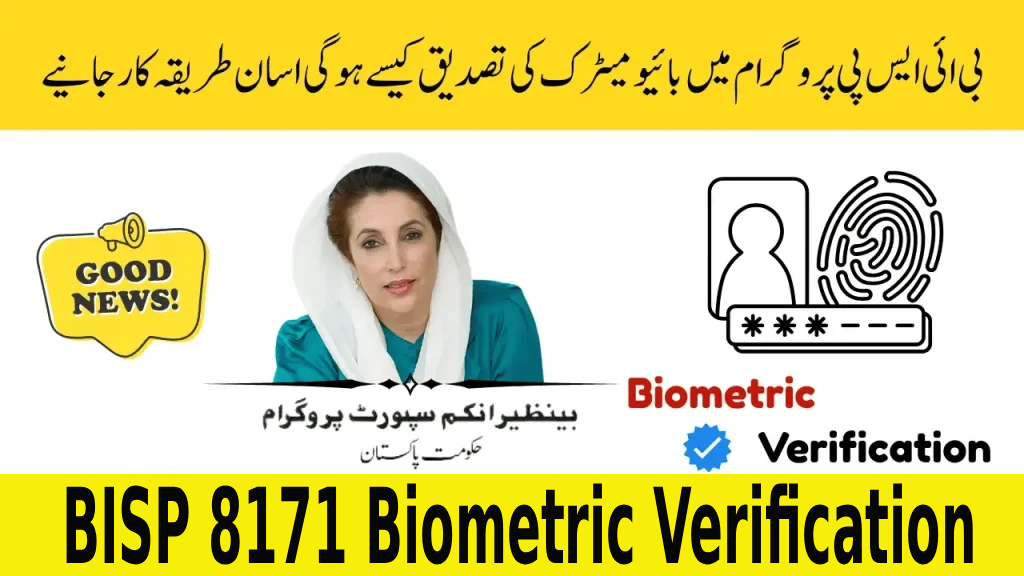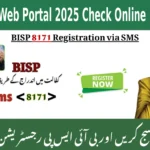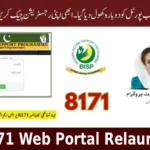
Introduction
If you’re a beneficiary of the Benazir Income Support Program (BISP), you’ve probably heard about BISP 8171 biometric verification. This process is crucial because, without successful biometric verification, you cannot receive your financial assistance under the program. Many people, especially in rural areas, face difficulties in understanding how biometric verification works and why it’s so important. Don’t worry — this article breaks everything down in simple, clear language so you can understand the process, avoid common issues, and ensure smooth access to your payments.
What is BISP 8171 Biometric Verification?
BISP 8171 biometric verification is a process through which the government verifies the identity of beneficiaries using their fingerprints and identity records. This ensures that the right person receives the financial aid and prevents fraud.
In simple words: your fingerprint is matched with NADRA’s database. Once verified, you can collect your money from designated banks, retail shops, or BISP centers without any issues.
Why is Biometric Verification Required for BISP 8171?
The government introduced biometric verification for several reasons:
- Preventing fraud and corruption: Earlier, there were complaints of middlemen taking a share of the beneficiaries’ money. Biometric verification ensures payments go directly to the eligible person.
- Transparency: Every transaction is recorded and verified through fingerprints, leaving little room for manipulation.
- Accuracy in distribution: Only those who are registered and truly eligible under the BISP program receive assistance.
- Trust building: Beneficiaries can feel secure knowing their identity is protected.
So, while the system may sometimes feel like a hassle, it is designed to protect your rights.
How to Complete BISP 8171 Biometric Verification
Completing your biometric verification is quite simple if you follow the correct steps:
- Visit a nearby BISP center or partner bank branch (such as HBL or Bank Alfalah).
- Carry your original CNIC — without it, verification is not possible.
- Provide your fingerprints at the biometric machine.
- Once the system verifies your identity, you will be able to collect your financial assistance.
- In case of issues, you may be guided to a NADRA office for re-verification.
Tip: Always ensure your CNIC is valid and not expired before visiting the center.
Common Problems in BISP 8171 Biometric Verification
Many people face challenges during the verification process. Here are the most common ones:
- Fingerprint mismatch: Older beneficiaries or those with worn-out fingerprints sometimes face difficulty.
- CNIC issues: If your CNIC is expired, blocked, or not updated in NADRA’s system, the verification may fail.
- Technical errors: Sometimes, machines may not function properly, especially in rural branches.
- Multiple attempts failure: If your fingerprints don’t match after several tries, you may be referred to NADRA.
Solution: In such cases, updating your records at NADRA is usually the best option. You can also request a manual review of your case.
Steps to Fix Biometric Verification Issues
If your BISP 8171 biometric verification fails, don’t panic. Here’s what you can do:
- Visit NADRA: Update your fingerprints and CNIC details.
- Reattempt verification: After updating records, go back to the BISP center or bank branch.
- Contact BISP helpline (8171): Explain your problem and request guidance.
- Escalate the issue: If the problem persists, visit the BISP tehsil office for further assistance.
By following these steps, most beneficiaries successfully resolve their issues.
Benefits of Biometric Verification for BISP Beneficiaries
At first, biometric verification may seem like a hurdle, but it comes with many benefits:
- Direct access to funds without middlemen.
- Faster processing once fingerprints are verified.
- Increased security of your payments.
- Confidence and trust in the system.
In short, it’s a safeguard for beneficiaries and ensures fairness in distribution.
Latest Updates on BISP 8171 Biometric Verification
The government frequently updates the process to make it easier for people. Recent changes include:
- Expanding biometric machines at more centers and retail outlets.
- Improving NADRA’s system to handle fingerprint issues.
- Offering alternative verification methods for elderly or disabled beneficiaries.
Keeping track of these updates helps beneficiaries avoid confusion and delays.
FAQs about BISP 8171 Biometric Verification
1. What should I do if my biometric verification fails?
If your biometric verification fails, visit the nearest NADRA office to update your fingerprints and then try again at a BISP center or bank.
2. Can I receive BISP payment without biometric verification?
No, biometric verification is mandatory for receiving BISP payments. It ensures transparency and prevents fraud.
3. What documents are required for biometric verification?
You only need your original CNIC. In some cases, you may be asked for a copy of your CNIC as well.
4. Is there any fee for biometric verification?
No, biometric verification for BISP beneficiaries is free of cost.
5. Can elderly people with weak fingerprints still get verified?
Yes, if fingerprints do not match, they can visit NADRA for fingerprint updates or use alternative verification methods offered by BISP.
Conclusion
The BISP 8171 biometric verification system is a vital step in ensuring that financial assistance reaches the rightful beneficiaries in Pakistan. While some may face difficulties due to fingerprint issues or technical errors, solutions are available through NADRA updates and BISP support centers. Ultimately, biometric verification is not just a requirement — it’s a protection for your rights and a guarantee that your money goes directly into your hands.
By understanding the process, staying updated, and knowing how to solve common problems, you can ensure smooth access to your BISP payments without unnecessary delays.

